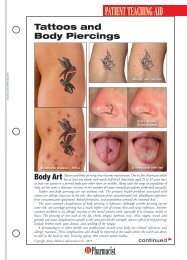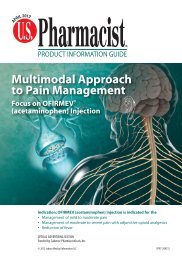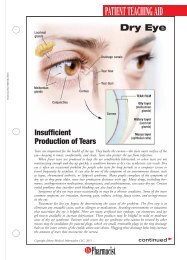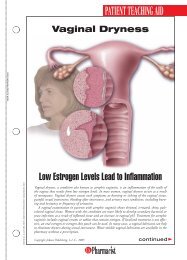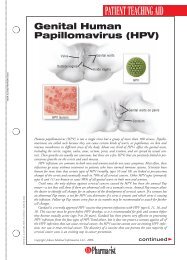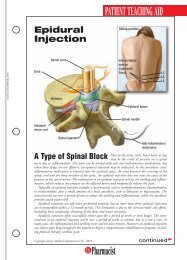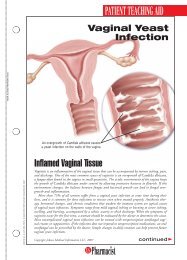View PDF Edition - U.S. Pharmacist
View PDF Edition - U.S. Pharmacist
View PDF Edition - U.S. Pharmacist
You also want an ePaper? Increase the reach of your titles
YUMPU automatically turns print PDFs into web optimized ePapers that Google loves.
Patients, family members and caregivers should be instructed to keep patches (new and used) out of the reachof children and others for whom fentanyl transdermal system was not prescribed. A considerable amount of activefentanyl remains in fentanyl transdermal system even after use as directed. Accidental or deliberate application oringestion by a child or adolescent will cause respiratory depression that could result in death.Cardiac Disease: Fentanyl may produce bradycardia. Fentanyl should be administered with caution to patients withbradyarrhythmias.Hepatic or Renal Disease: Insufficient information exists to make recommendations regarding the use of fentanyltransdermal system in patients with impaired renal or hepatic function. If the drug is used in these patients, it shouldbe used with caution because of the hepatic metabolism and renal excretion of fentanyl.Use in Pancreatic/Biliary Tract Disease: Fentanyl transdermal system may cause spasm of the sphincter of Oddi andshould be used with caution in patients with biliary tract disease, including acute pancreatitis. Opioids like fentanyltransdermal system may cause increases in the serum amylase concentration.Tolerance: Tolerance is a state of adaptation in which exposure to a drug induces changes that result in a diminutionof one or more of the drug’s effects over time. Tolerance may occur to both the desired and undesired effects ofdrugs, and may develop at different rates for different effects.Physical Dependence: Physical dependence is a state of adaptation that is manifested by an opioid specificwithdrawal syndrome that can be produced by abrupt cessation, rapid dose reduction, decreasing blood level of thedrug, and/or administration of an antagonist. The opioid abstinence or withdrawal syndrome is characterized by someor all of the following: restlessness, lacrimation, rhinorrhea, yawning, perspiration, chills, piloerection, myalgia,mydriasis, irritability, anxiety, backache, joint pain, weakness, abdominal cramps, insomnia, nausea, anorexia,vomiting, diarrhea, or increased blood pressure, respiratory rate, or heart rate. In general, opioids should not beabruptly discontinued (see DOSAGE AND ADMINISTRATION: Discontinuation of Fentanyl Transdermal System in fullprescribing information).Ambulatory Patients: Strong opioid analgesics impair the mental or physical abilities required for the performance ofpotentially dangerous tasks, such as driving a car or operating machinery. Patients who have been given fentanyltransdermal system should not drive or operate dangerous machinery unless they are tolerant to the effects of the drug.Information for Patients: Patients and their caregivers should be provided with a Medication Guide each timefentanyl transdermal system is dispensed because new information may be available.Patients receiving fentanyl transdermal system should be given the following instructions by the physician:1. Patients should be advised that fentanyl transdermal systems contain fentanyl, an opioid pain medicinesimilar to morphine, hydromorphone, methadone, oxycodone, and oxymorphone.2. Patients should be advised that each fentanyl transdermal system may be worn continuously for 72 hours, andthat each patch should be applied to a different skin site after removal of the previous transdermal patch.3. Patients should be advised that fentanyl transdermal system should be applied to intact, nonirritated, andnonirradiated skin on a flat surface such as the chest, back, flank, or upper arm. Additionally, patients shouldbe advised of the following:• In young children or persons with cognitive impairment, the patch should be put on the upper back to lowerthe chances that the patch will be removed and placed in the mouth.• Hair at the application site should be clipped (not shaved) prior to patch application.• If the site of fentanyl transdermal system application must be cleansed prior to application of the patch,do so with clear water.• Do not use soaps, oils, lotions, alcohol, or any other agents that might irritate the skin or alter itscharacteristics.• Allow the skin to dry completely prior to patch application.4. Patients should be advised that fentanyl transdermal system should be applied immediately upon removal from thesealed package and after removal of the protective liner. Additionally the patient should be advised of the following:• The fentanyl transdermal system should not be used if the seal is broken or the patch is cut, damaged, orchanged in any way.• The transdermal patch should be pressed firmly in place with the palm of the hand for 30 seconds,making sure the contact is complete, especially around the edges.• The patch should not be folded so that only part of the patch is exposed.5. Patients should be advised that the dose of fentanyl transdermal system or the number of patches applied tothe skin should NEVER be adjusted without the prescribing healthcare professional’s instruction.6. Patients should be advised that while wearing the patch, they should avoid exposing the fentanyl transdermalsystem application site and surrounding area to direct external heat sources, such as:• heating pads,• electric blankets,• sunbathing,• heat or tanning lamps,• saunas,• hot tubs or hot baths, and• heated water beds, etc.7. Patients should also be advised of a potential for temperature-dependent increases in fentanyl release from thepatch that could result in an overdose of fentanyl; therefore, patients who develop a high fever or increased bodytemperature due to strenuous exertion while wearing the patch should contact their physician.8. Patients should be advised that if they experience problems with adhesion of the fentanyl transdermal system,they may tape the edges of the patch with first aid tape. If problems with adhesion persist, patients mayoverlay the patch with a transparent adhesive film dressing (e.g., Bioclusive ® or Askina ® Derm).9. Patients should be advised that if the patch falls off before 72 hours a new patch may be applied to adifferent skin site.10. Patients should be advised to fold (so that the adhesive side adheres to itself) and immediately flush downthe toilet used fentanyl transdermal systems after removal from the skin.11. Patients should be advised that fentanyl transdermal system may impair mental and/or physical abilityrequired for the performance of potentially hazardous tasks (e.g., driving, operating machinery).12. Patients should be advised to refrain from any potentially dangerous activity when starting on fentanyltransdermal system or when their dose is being adjusted, until it is established that they have not beenadversely affected.13. Patients should be advised that fentanyl transdermal system should not be combined with alcohol or other CNSdepressants (e.g., sleep medications, tranquilizers) because dangerous additive effects may occur, resultingin serious injury or death.14. Patients should be advised to consult their physician or pharmacist if other medications are being or will beused with fentanyl transdermal system.15. Patients should be advised of the potential for severe constipation.16. Patients should be advised that if they have been receiving treatment with fentanyl transdermal system andcessation of therapy is indicated, it may be appropriate to taper the fentanyl transdermal system dose, ratherthan abruptly discontinue it, due to the risk of precipitating withdrawal symptoms.17. Patients should be advised that fentanyl transdermal system contains fentanyl, a drug with high potentialfor abuse.18. Patients, family members and caregivers should be advised to protect fentanyl transdermal system from theftor misuse in the work or home environment.19. Patients should be instructed to keep fentanyl transdermal system in a secure place out of the reach ofchildren due to the high risk of fatal respiratory depression.20. Patients should be advised that fentanyl transdermal system should never be given to anyone other than theindividual for whom it was prescribed because of the risk of death or other serious medical problems to thatperson for whom it was not intended.21. Patients should be informed that, if the patch dislodges and accidentally sticks to the skin of another person,they should immediately take the patch off, wash the exposed area with water and seek medical attention forthe accidentally exposed individual.22. When fentanyl transdermal system is no longer needed, the unused patches should be removed from theirpouches, folded so that the adhesive side of the patch adheres to itself, and flushed down the toilet.23. Women of childbearing potential who become, or are planning to become pregnant, should be advised toconsult a physician prior to initiating or continuing therapy with fentanyl transdermal system.24. Patients should be informed that accidental exposure or misuse may lead to death or other serious medicalproblems.Drug Interactions: Agents Affecting Cytochrome P450 3A4 Isoenzyme System: Fentanyl is metabolized mainlyvia the human cytochrome P450 3A4 isoenzyme system (CYP3A4), therefore potential interactions may occur whenfentanyl transdermal system is given concurrently with agents that affect CYP3A4 activity. Coadministration withagents that induce CYP3A4 activity may reduce the efficacy of fentanyl transdermal system. The concomitant useof transdermal fentanyl with all CYP3A4 inhibitors (such as ritonavir, ketoconazole, itraconazole, troleandomycin,clarithromycin, nelfanivir, nefazadone, amiodarone, amprenavir, aprepitant, diltiazem, erythromycin, fluconazole,fasamprenavir, grapefruit juice, and verapamil) may result in an increase in fentanyl plasma concentrations, whichcould increase or prolong adverse drug effects and may cause fatal respiratory depression. Patients receivingfentanyl transdermal system and any CYP3A4 inhibitor should be carefully monitored for an extended period of time,and dosage adjustments should be made if warranted (see BOX WARNING, CLINICAL PHARMACOLOGY: DrugInteractions in full prescribing information, WARNINGS, and DOSAGE AND ADMINISTRATION in full prescribinginformation for further information).Central Nervous System Depressants: The concomitant use of fentanyl transdermal system with other centralnervous system depressants, including but not limited to other opioids, sedatives, hypnotics, tranquilizers (e.g.,benzodiazepines), general anesthetics, phenothiazines, skeletal muscle relaxants, and alcohol, may cause respiratorydepression, hypotension, and profound sedation, or potentially result in coma or death. When such combined therapyis contemplated, the dose of one or both agents should be significantly reduced.MAO Inhibitors: Fentanyl transdermal system is not recommended for use in patients who have received MAOI within14 days because severe and unpredictable potentiation by MAO inhibitors has been reported with opioid analgesics.Carcinogenesis, Mutagenesis, and Impairment of Fertility: Studies in animals to evaluate the carcinogenicpotential of fentanyl HCl have not been conducted. There was no evidence of mutagenicity in the Ames Salmonellamutagenicity assay, the primary rat hepatocyte unscheduled DNA synthesis assay, the BALB/c 3T3 transformationtest, and the human lymphocyte and CHO chromosomal aberration in vitro assays.The potential effects of fentanyl on male and female fertility were examined in the rat model via two separateexperiments. In the male fertility study, male rats were treated with fentanyl (0, 0.025, 0.1 or 0.4 mg/kg/day) viacontinuous intravenous infusion for 28 days prior to mating; female rats were not treated. In the female fertility study,female rats were treated with fentanyl (0, 0.025, 0.1 or 0.4 mg/kg/day) via continuous intravenous infusion for14 days prior to mating until day 16 of pregnancy; male rats were not treated. Analysis of fertility parameters in bothstudies indicated that an intravenous dose of fentanyl up to 0.4 mg/kg/day to either the male or the female aloneproduced no effects on fertility (this dose is approximately 1.6 times the daily human dose administered by a 100 mcg/hrpatch on a mg/m 2 basis). In a separate study, a single daily bolus dose of fentanyl was shown to impair fertility inrats when given in intravenous doses of 0.3 times the human dose for a period of 12 days.Pregnancy: Teratogenic Effects: Pregnancy Category C: No epidemiological studies of congenital anomalies ininfants born to women treated with fentanyl during pregnancy have been reported.The potential effects of fentanyl on embryo-fetal development were studied in the rat, mouse, and rabbit models.Published literature reports that administration of fentanyl (0, 10, 100, or 500 mcg/kg/day) to pregnant femaleSprague-Dawley rats from day 7 to 21 via implanted microosmotic minipumps did not produce any evidence ofteratogenicity (the high dose is approximately 2 times the daily human dose administered by a 100 mcg/hr patch ona mg/m 2 basis). In contrast, the intravenous administration of fentanyl (0, 0.01, or 0.03 mg/kg) to bred female ratsfrom gestation day 6 to 18 suggested evidence of embryotoxicity and a slight increase in mean delivery time in the0.03 mg/kg/day group. There was no clear evidence of teratogenicity noted.Pregnant female New Zealand White rabbits were treated with fentanyl (0, 0.025, 0.1, 0.4 mg/kg) via intravenousinfusion from day 6 to day 18 of pregnancy. Fentanyl produced a slight decrease in the body weight of the live fetusesat the high dose, which may be attributed to maternal toxicity. Under the conditions of the assay, there was noevidence for fentanyl induced adverse effects on embryo-fetal development at doses up to 0.4 mg/kg (approximately3 times the daily human dose administered by a 100 mcg/hr patch on a mg/m 2 basis).There are no adequate and well controlled studies in pregnant women. Fentanyl transdermal system should beused during pregnancy only if the potential benefit justifies the potential risk to the fetus.Nonteratogenic Effects: Chronic maternal treatment with fentanyl during pregnancy has been associated withtransient respiratory depression, behavioral changes, or seizures characteristic of neonatal abstinence syndrome innewborn infants. Symptoms of neonatal respiratory or neurological depression were no more frequent than expectedin most studies of infants born to women treated acutely during labor with intravenous or epidural fentanyl. Transientneonatal muscular rigidity has been observed in infants whose mothers were treated with intravenous fentanyl.The potential effects of fentanyl on prenatal and postnatal development were examined in the rat model. FemaleWistar rats were treated with 0, 0.025, 0.1, or 0.4 mg/kg/day fentanyl via intravenous infusion from day 6 ofpregnancy through 3 weeks of lactation. Fentanyl treatment (0.4 mg/kg/day) significantly decreased body weight in maleand female pups and also decreased survival in pups at day 4. Both the mid-dose and high-dose of fentanyl animalsdemonstrated alterations in some physical landmarks of development (delayed incisor eruption and eye opening) andtransient behavioral development (decreased locomotor activity at day 28 which recovered by day 50). The mid-doseand the high-dose are 0.4 and 1.6 times the daily human dose administered by a 100 mcg/hr patch on a mg/m 2 basis.Labor and Delivery: Fentanyl readily passes across the placenta to the fetus; therefore, fentanyl transdermal systemis not recommended for analgesia during labor and delivery.Nursing Mothers: Fentanyl is excreted in human milk; therefore, fentanyl transdermal system is not recommended foruse in nursing women because of the possibility of effects in their infants.Pediatric Use: The safety of fentanyl transdermal system was evaluated in three open-label trials in 291 pediatricpatients with chronic pain, 2 years of age through 18 years of age. Starting doses of 25 mcg/hr and higher were usedby 181 patients who had been on prior daily opioid doses of at least 45 mg/day of oral morphine or an equianalgesicdose of another opioid. Initiation of fentanyl transdermal system therapy in pediatric patients taking less than60 mg/day of oral morphine or an equianalgesic dose of another opioid has not been evaluated in controlled clinicaltrials. Approximately 90% of the total daily opioid requirement (fentanyl transdermal system plus rescue medication)was provided by fentanyl transdermal system.Fentanyl transdermal system was not studied in children under 2 years of age.Fentanyl transdermal system should be administered to children only if they are opioid-tolerant and 2 years of ageor older (see DOSAGE AND ADMINISTRATION in full prescribing information and BOX WARNING).To guard against accidental ingestion by children, use caution when choosing the application site for fentanyltransdermal system (see DOSAGE AND ADMINISTRATION in full prescribing information) and monitor adhesion of thesystem closely.Geriatric Use: Information from a pilot study of the pharmacokinetics of IV fentanyl in geriatric patients (N = 4)indicates that the clearance of fentanyl may be greatly decreased in the population above the age of 60. The relevanceof these findings to fentanyl transdermal system is unknown at this time.Respiratory depression is the chief hazard in elderly or debilitated patients, usually following large initial doses innontolerant patients, or when opioids are given in conjunction with other agents that depress respiration.Fentanyl transdermal system should be used with caution in elderly, cachectic, or debilitated patients as theymay have altered pharmacokinetics due to poor fat stores, muscle wasting or altered clearance (see DOSAGE ANDADMINISTRATION in full prescribing information).ADVERSE REACTIONS: In post-marketing experience, deaths from hypoventilation due to inappropriate use offentanyl transdermal system have been reported (see BOX WARNING and CONTRAINDICATIONS).Premarketing Clinical Trial Experience: Although fentanyl transdermal system use in postoperative or acute painand in patients who are not opioid-tolerant is CONTRAINDICATED, the safety of fentanyl transdermal system wasoriginally evaluated in 357 postoperative adult patients for 1 to 3 days and 153 cancer patients for a total of 510patients. The duration of fentanyl transdermal system use varied in cancer patients; 56% of patients used fentanyltransdermal system for over 30 days, 28% continued treatment for more than 4 months, and 10% used fentanyltransdermal system for more than 1 year.Hypoventilation was the most serious adverse reaction observed in 13 (4%) postoperative patients and in 3 (2%) ofthe cancer patients. Hypotension and hypertension were observed in 11 (3%) and 4 (1%) of the opioid-naive patients.Various adverse events were reported; a causal relationship to fentanyl transdermal system was not alwaysdetermined. The frequencies presented here reflect the actual frequency of each adverse effect in patients whoreceived fentanyl transdermal system. There has been no attempt to correct for a placebo effect, concomitant use ofPage 2 of 3




